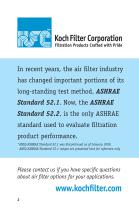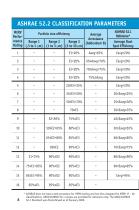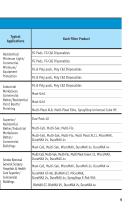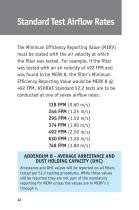 Website:
Koch Filter Corporation
Website:
Koch Filter Corporation
Catalog excerpts

Koch Filter Corporation Filtration Products Crafted with Pride The Updated Air Fitter Standard Koch Filter Corporation. ..Durable. Reliable. Versatile.
Open the catalog to page 1
Koch Filter Corporation Filtration Products Crafted with Pride In recent years, the air filter industry has changed important portions of its long-standing test method, ASHRAE Standard 52.2, is the only ASHRAE standard used to evaluate filtration product performance. *ANSI/ASHRAE Standard 52.1 was discontinued as of January 2009, ANSI/ASHRAE Standard 52.1 ranges are presented here for reference only Please contact us if you have specific questions about air filter options for your applications.
Open the catalog to page 2
Who is ASHRAE? The American Society of Heating, Refrigerating and Air-Conditioning Engineers (ASHRAE), founded in 1894, is an international organization of 51,000 members. ASHRAE fulfills its mission of advancing heating, ventilation, air conditioning and refrigeration to serve humanity and promote a sustainable world through research, standards writing, publishing and continuing education. The latest ASHRAE Standard, in the works since 1987, is titled ASHRAE Standard 52.2-2007: Method of Testing General Ventilation Air-Cleaning Devices for Removal Efficiency by Particle Size and is...
Open the catalog to page 3
How Data Is Obtained An air filter’s performance is determined by measuring the particle counts upstream and downstream of the air-cleaning device being tested. Test Standard Comparison Chart The chart below is useful in understanding the relationship Standard 52.2-2007, E1, E2, E3 and European Test Standard Average Arrestance Source: Mr. Robert Burkhead, President of Blue Heaven Technologies, Louisville, Kentucky. MERV 2 MERV 3 MERV 4
Open the catalog to page 4
Particle counts are taken over the range of particle sizes six times, beginning with a clean filter and then after the addition of standard synthetic ASHRAE dust loadings for five additional measurement cycles. A laboratory aerosol generator, which operates much like a paint sprayer, is used to create a challenge aerosol of known particle size in the air between ASHRAE Test Standard 52.1-1999, ASHRAE Test EN 779. 52.1 Dust Spot Efficiency E3 Particle Size Efficiency (3 to 10µm) E2 Particle Size Efficiency (1 to 3µm) E1 Particle Size Efficiency (.3 to 1µm) Efficiency on .4µm...
Open the catalog to page 5
stream. This will generate particles covering the 12 required particle size ranges for the test (See ANSI/ASHRAE 52.2 Particle Size Ranges Chart). ANSI/ASHRAE 52.2 PARTICLE SIZE RANGES Range 1
Open the catalog to page 6
The challenge aerosol is injected into the test duct and particle counts are taken for each of the size data points. The filter’s performance, on each of the twelve particle sizes, during the six test cycles (a total of 72 measurements) is determined. For each measurement, the filtration efficiency is stated as a ratio of the downstream-to-upstream particle count. The lowest values over the six test cycles are then used to determine the Composite Minimum Efficiency Curve. Using the lowest measured efficiency avoids the misinterpretation of averaging and provides a “worst case” experience...
Open the catalog to page 7
ASHRAE 52.2 CLASSIFICATION PARAMETERS MERV Particle size efficiency Average PerforArrestance mance Range 1 Range 2 Range 3 (Addendum B) Rating (.3 to 1 μm) (1 to 3 μm) (3 to 10 μm) ASHRAE 52.1 Reference* Average Dust Spot Efficiency * ASHRAE does not have a test procedure for HEPA testing and has thus dropped the MERV 17 - 20 classifications. ANSI/ASHRAE 52.1 ranges are provided for reference only. The ANSI/ASHRAE 52.1 Standard was discontinued as of January 2009.
Open the catalog to page 8
Typical Applications Residential/ Minimum Light/ Commercial Minimum/ Equipment Protection Industrial Workplaces Commercial Better/Residential Paint Booth/ Finishing Superior/ Residential Better/Industrial Workplaces Better/ Commercial Buildings Smoke Removal General Surgery Hospitals & Health Care Superior/ Commercial Buildings Koch Filter Product FG Pads, FG C&I Disposables FG Pads, FG C&I Disposables FG & Poly pads, Poly C&I Disposables FG & Poly pads, Poly C&I Disposables FG & Poly pads, Poly C&I Disposables Maxi-Grid Maxi-Grid Multi-Pleat XL8, Multi-Pleat Elite, SprayStop Universal Cube...
Open the catalog to page 9
What has changed? ASHRAE Standard 52.1 was used as the industry standard for several decades. A main component of Standard 52.1 was the Average Dust Spot Efficiency Tests. The new standard, however, evaluates air filter efficiency as a function of particle size. The new test method determines the ability of an air filter to remove dust by specific particle sizes ranging from 0.3 micrometers (µm) to 10 micrometers (µm). This advancement led to the creation of a Minimum Efficiency Reporting Value (MERV) to determine the performance of each filter tested. MERV is a central feature of ASHRAE...
Open the catalog to page 10
MERV Performance The Minimum Efficiency Reporting Value, or MERV, is a guideline to inform consumers how efficient a filter will be when installed. MERV 1-4 air filters are typically disposable panel filters or pads and are used primarily to protect equipment from particles no smaller than 10 micrometers. MERV 5-8 air filters are a better choice and more commonly found in both residential and commercial applications. They are capable of effectively collecting particles as small as 3 micrometers. MERV 9-12 air filters are used in commercial and industrial settings, or in residential, where...
Open the catalog to page 11
Standard Test Airflow Rates The Minimum Efficiency Reporting Value (MERV) must be stated with the air velocity at which the filter was tested. For example, if the filter was tested with an air velocity of 492 FPM and was found to be MERV 8, the filter’s Minimum Efficiency Reporting Value would be MERV 8 @ 492 FPM. ASHRAE Standard 52.2 tests are to be conducted at one of seven airflow rates: 118 FPM (0.60 m/s) 246 FPM (1.25 m/s) 295 FPM (1.50 m/s) 374 FPM (1.90 m/s) 492 FPM (2.50 m/s) 630 FPM (3.20 m/s) 748 FPM (3.80 m/s) ADDENDUM B - AVERAGE ARRESTANCE AND DUST HOLDING CAPACITY (DHC)...
Open the catalog to page 12All Koch Filter Corporation catalogs and technical brochures
-
Disposable Filters
2 Pages
-
DuraMAX™ 4vS
1 Pages
-
Maxi-Cell™
2 Pages
-
BioMAX™
2 Pages
-
Multi-Cell™
2 Pages
-
Synthetic Air Filter Media
2 Pages
-
KDF 600
1 Pages
-
Multi-Test Series
1 Pages
-
Maxi-Grid
2 Pages
-
OdorKleen250
2 Pages
-
Multi-45
1 Pages
-
Multi-Pleat XL11
2 Pages
-
Multi-Pleat GT-HD
1 Pages
-
Multi-Pleat BOSS
2 Pages
-
MicroMAXPL6
2 Pages
-
KDF600
1 Pages
-
SyntheticMedia
2 Pages
-
Multi-Pleat GT
1 Pages
-
MicroMAX Edge brochure
2 Pages
-
DuoCap
1 Pages
-
DuraMAX4v32
1 Pages
-
BioMAX HEPA
2 Pages
-
BioMAX V2000
1 Pages
-
BioMAX CS - Brochure
2 Pages
-
HogsHair
1 Pages
-
DuraPURE
2 Pages
-
DuraMAX 4vS
1 Pages
-
DuraMAX2vS
1 Pages
-
Duo-Pak 40
1 Pages
-
Pad Holding Frames
1 Pages
-
SprayStop E-Pak 650™
2 Pages
-
SprayStop E-Pak 950™
2 Pages
-
SprayStop Expanded Paper
2 Pages
-
SprayStop FG
1 Pages
-
SprayStop HC Duo-Pak™
2 Pages
-
SprayStop HCX
2 Pages
-
Paint Pockets™
2 Pages
-
SprayStop S Duo-Pak™
2 Pages
-
SprayStop SHC™
1 Pages
-
SprayStop S™
1 Pages
-
SprayStop Universal Cube HC™
2 Pages
-
SprayStop Universal Cube HE™
2 Pages
-
Supergrade Fiberglass
1 Pages
-
Synthetic Air Filter Media
2 Pages
-
Synthetic Hogshair Media
1 Pages
-
Type AR Filter Holding Frame
2 Pages
-
Multi-Cell™
4 Pages
-
MicroMAX™
4 Pages
-
Multi-Flo™
2 Pages
-
Multi-Sak™
6 Pages
-
Multi-Pleat Green 13™
2 Pages
-
Koch ICF
2 Pages
-
Maxi-Grid?
6 Pages





























































